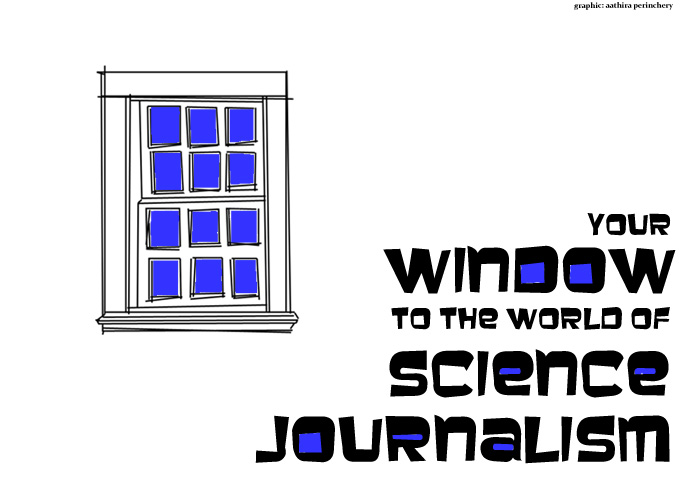Your window to the world of science journalism
The Science Journalism Course is back at NCBS, now accepting applications for its 2012 batch. But what was it like to be part of the first course held in 2011? What are its alumni doing now? That's something this year's prospective participants will be curious to know.
"We would like to get the students ready to start writing basic science articles for magazines, newspapers and websites," Anil Ananthaswamy, the organizer and one of the instructors of the course had said when I interviewed him before the course last year. (You can visit the article here). But precisely what goes into these articles? Not many of us participants were sure until the course began. "My idea of science journalism was quite vague; I did not fully comprehend the process that went behind a popular science piece," says Sandhya Sekar, one of the ten participants of the first batch.
The first challenge came in knowing exactly what you're writing about - and Geoff Hyde's one day seminar on how to break down a scientific paper made that a lot easier. Hyde is the Coordinator of science communication at NCBS. Peter Aldhous (Bureau chief of the New Scientist magazine at San Francisco, USA) taught the basics of writing good news stories, while Ananthaswamy (Consultant with the New Scientist) dealt with the details of feature-writing. The course involved reading scientific papers in class, breaking them down to their most important facts and findings, and writing "stories" in precise, lucid language. We were taught the importance of good reporting, vivid quotes and lively language, and even participated in a mock scientific conference, based on which we had to write a news story. The instructors often stressed the importance of story-telling-the bedrock of good science writing. Discussion topics ranged from investigative journalism to the ethics of writing.
In the previous interview, one thing the instructors said they hoped the course would accomplish was introduce participants to writing articles under pressure, keeping in mind the very short deadlines and huge time constraints that are commonplace in science journalism. And that's exactly what it did. Condensing research that took years of work into an article a mere 300-words long, coupled with strict time limits for writing them in class, was not easy. While writing stories, it was often difficult for the scientist in us to let go of complicated redundant information that we thought was important. But the instructors' constructive feedback helped greatly, facilitated by open discussions about each written piece at the end of every exercise.
Apart from learning the essentials of conducting good interviews and structuring stories, we also understood the importance of objectivity: that a science journalist's job is not to give his or her own, perhaps-biased views about the scientific work that is being talked about, but to get views from experts independent of the original research team so that readers can take the call themselves. "Never underestimate your readers," is what both Aldhous and Ananthaswamy said.
Understanding a reader's psyche and writing to grab the reader's attention was pretty tough. But the ten-day intensive course has paid off. "The course definitely gave me the confidence that I had the tools to write a popular science piece," says Sekar, who is completing her doctoral degree in ecology at the Indian Institute of Science, Bangalore. She has started writing for prestigious publications such as Nature India. Her success has given her the impetus to take up science writing as a career after her doctorate, despite a productive doctoral stint that has resulted in a paper already and will lead to more over the next year. "The comforting thought that there is a career in it helped me make the leap," she says. "What precipitated it even more was browsing through science news pieces in India, and finding a) very few high quality pieces, b) few pure science pieces (not focused on technological and medical applications) and at a more personal level, c) very few hard core ecology pieces, which are pure ecology and not conservation based," she adds.
Another alumnus Meghna Krishnadas thinks the best things about the course were interacting with people interested in writing and communication and learning the nuances of what she thought was merely a natural skill. "The course has helped me streamline my writing, in terms of organizing structure and content," says Krishnadas, a research fellow at NCBS. "It has certainly helped me improve and evaluate my own writing skills better, and I review what I write from a different perspective now," she says. She continues to write about ecology and conservation in national print media. Jacob Koshy, a journalist with LiveMint (Calcutta) who took part in the course as well continues to write science stories for his publisher.
The instructors say they had a wonderful time teaching the first course. "We were pleasantly surprised by the quality of the students and the intensity of the interactions," says Ananthaswamy. "And NCBS provided the perfect environment for such a course, intellectually and administratively."
The second course, says Ananthaswamy, will be along the lines of the first. "But we'll incorporate some changes based on comments from students," he says. For instance, the upcoming course will be conducted across 17 days covering the same material as the first, which was only 10 days long - "mainly to allow more time for students to write a feature article," says Ananthaswamy. People outside of NCBS are also encouraged to apply this time.
Organizers are calling for applications to the second science journalism course till the 10th of June 2012. So grab the opportunity while it lasts: a once-a-year chance that will be your window to the world of science writing.
You can access the official announcement for the second course with more details at http://news.ncbs.res.in/story/second-science-journalism-course-ncbs.
Comments
Post new comment